Kerala Legislative Assembly
The Kerala Legislative Assembly, popularly known as the Niyamasabha (lit. 'Law Council'), is the State Assembly of Kerala, one of the 28 States in India. The Assembly is formed by 140 elected representatives.[1] Each elected member represents one of the 140 constituencies within the borders of Kerala and is referred to as Member of the Legislative Assembly (MLA).The present Kerala Legislative Assembly consists of 140 elected members and one member nominated by the Governor from the Anglo-Indian Community.
Kerala Legislative Assembly Kerala Niyamasabha | |
|---|---|
| 14th Legislative Assembly of Kerala | |
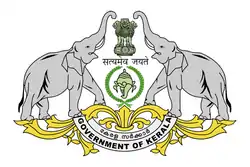 | |
| Type | |
| Type | |
Term limits | 5 years |
| Leadership | |
Speaker | |
Deputy Speaker | |
Leader of the House (Chief Minister) | |
Leader of the Opposition | |
| Structure | |
| Seats | 140 |
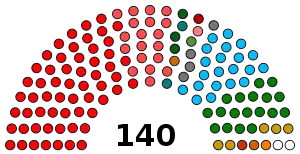 | |
Political groups | Government (92)
LDF (92) Opposition (42) UDF (42) Others (2) Vacant (4)
|
| Elections | |
| First past the post | |
Last election | 16 May 2016 |
Next election | May 2021 |
| Meeting place | |
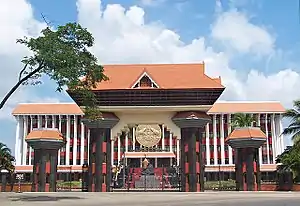 | |
| Niyamasabha Mandiram, Thiruvananthapuram, Kerala | |
| Website | |
| www | |
History
The evolution of Kerala Legislative Assembly begins with the formation of a Legislative Council in the princely state of Travancore in 1888. This was the first Native Legislature in the Indian subcontinent, outside British India. The Legislative Council of Travancore had undergone many changes by years. In the meantime, people's participation in the Assembly was widely sought. All those efforts led to the formation of one more representative body, namely the Sri Moolam Popular Assembly of Travancore. This Assembly of the representatives of the landholders and merchants, aimed at giving the people an opportunity of bringing to the notice of Government their requirements, wishes or grievances on the one hand, and on the other, to make the policy and measures of Government better known to the people so that all possible grounds of misconception may be removed. That was on 1 October 1904.
Though the popular assembly contained representatives of tax-payers, it finally became a people's representatives body. Political awareness and people agitations were aggressive and the authorities were forced to include peoples representatives into the popular assembly. On 1 May 1905, a regulation was issued to grant to the people the privilege of electing members to the Assembly. Of the 100 members, 77 were to be elected and 23 nominated, for a tenure of 1 year. The right to vote was given to persons who paid on their account an annual land revenue of not less than Rs. 50 or whose net income was not less than Rs. 2000 and to graduates of a recognized University, with not less than 10 years standing and having their residence in the taluk. The membership of the popular assembly increased year by year and finally in 1921 elected representatives gained the majority. By that time the house had 50 members of which 28 were elected and the rest nominated.
The princely state of Cochin also formed a Legislative Council (1925), with 30 elected and 15 nominated representatives. Malabar District of Madras Province under the British rule, had representatives in Madras Legislative Assembly from the 1920s.
After India's independence responsible governments were formed in Travancore and Cochin. In 1949 the merger of Travancore and Cochin as Travancore-Cochin, formed the first Legislative Assembly, the Travancore-Cochin Legislative Assembly composed of 178 members of the Legislative bodies of Travancore and Cochin. The Malabar region had representatives in the Madras Legislative Assembly.
Assembly after the formation of Kerala State

In 1956, the State of Kerala was formed on linguistic basis, merging Travancore, Cochin, and Malabar regions, and the Kasaragod Taluk of South Canara. The first assembly election in Kerala state was held in February–March 1957. The first Kerala Legislative Assembly was formed on 5 April 1957. The Assembly had 127 members including a nominated member.
The current delimitation committee of 2010 reaffirmed the total number of seats at 140.
Current assembly
The current Legislative Assembly is the 14th Assembly since the formation of Kerala. The Speaker of the Assembly is P. Sreeramakrishnan. The leader of the Assembly is Pinarayi Vijayan from CPI(M) and the Leader of the Opposition is Ramesh Chennithala from the INC. At the same time, the deputy leader of opposition is M. K. Muneer of IUML.
Niyamasabha Complex
The State Assembly is known as Niyamasabha and is housed in New Legislature Complex. This 5 storied complex is one of the largest complexes in India. The Central Hall is described as most elegant and majestic hall with ornamental Teakwood-Rosewood panelling. The older Assembly was located within State Secretariat complex which was reconverted into Legislature museum, after commissioning new complex in 1998 May 22 (K. R. Narayanan).
Political parties or coalitions
| No. | Front/Alliance | Seats |
|---|---|---|
| 1 | LDF | 92 |
| 2 | UDF | 42 |
| 3 | NDA | 1[2] |
| 4 | KJ(S) | 1[3] |
| 5 | Vacant | 4 |
Members

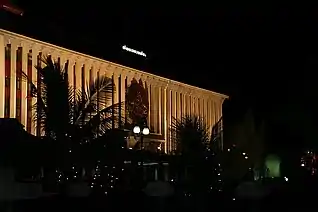
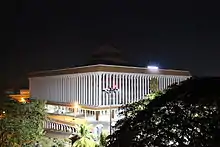
Key
CPI (M) CPI JD(S) NCP Cong(S) KC(B) RSP(L) INL Independent INC IUML KC(M) KC(J) BJP KJ (S)
Speakers of the Kerala Legislative Assembly[7]
| Sl. No. | Name | Period |
|---|---|---|
| 1 | R. Sankaranarayanan Thampi | 27 April 1957 – 31 July 1959 |
| 2 | K.M. Seethi Sahib | 12 March 1960 – 17 April 1961 |
| A. Nafeesath Beevi
(acting) |
18 April 1961 – 8 June 1961 | |
| 3 | C.H. Mohammed Koya | 9 June 1961 – 10 November 1961 |
| 4 | Alexander Parambithara | 13 December 1961 - 10 September 1964 |
| 5 | D. Damodaran Potti | 15 March 1967 – 21 October 1970 |
| 6 | K. Moideenkutty Haji | 22 October 1970 – 8 May 1975 |
| R. S. Unni
(acting) |
9 May 1975 – 16 February 1976 | |
| 7 | T. S. John | 17 February 1976 – 25 March 1977 |
| 8 | Chakkeeri Ahmedkutty | 28 March 1977 – 14 February 1980 |
| 9 | A.P. Kurian | 15 February 1980 – 1 February 1982 |
| 10 | A.C. Jose | 3 February 1982 – 23 June 1982 |
| 11 | Vakkom B. Purushothaman | 24 June 1982 – 28 December 1984 |
| K. M. Hamza Kunju
(acting) |
29 December 1984 – 7 March 1985 | |
| 12 | V. M. Sudheeran | 8 March 1985 – 27 March 1987 |
| 13 | Varkala Radhakrishnan | 30 March 1987 – 28 June 1991 |
| 14 | P. P. Thankachan | 1 July 1991 – 3 May 1995 |
| K. Narayana Kurup
(acting) |
4 May 1995 – 26 June 1995 | |
| 15 | Therambil Ramakrishnan | 27 June 1995 – 28 May 1996 |
| 16 | M. Vijayakumar | 30 May 1996 – 4 June 2001 |
| 17 | Vakkom Purushothaman | 6 June 2001 - 4 September 2004 |
| N. Sundaran Nadar
(acting) |
5 September 2004 – 16 September 2004 | |
| 18 | Therambil Ramakrishnan | 16 September 2004 – 24 May 2006 |
| 19 | K.Radhakrishnan | 25 May 2006 – 31 May 2011 |
| 20 | G. Karthikeyan | 2 June 2011 – 7 March 2015 |
| 21 | N. Sakthan | 12 March 2015 – 1 June 2016 |
| 22 | P. Sreeramakrishnan | 3 June 2016- present |
Composition
The Assembly consists of 140 Members known as Members of Legislative Assembly- MLA representing each constituency.
The qualifications needed to become an MLA are almost similar to the eligibility criteria for an MP. Besides being a citizen of India, the individual should not be less than 25 years of age. On a more fundamental note, a person, who is not a voter from any constituency of the state, is not eligible to become an MLA.
It's to be noted that an MLA is elected by the people of a particular constituency, and the MLA represents those electorates in the Legislative Assembly. MLAs enjoy the same position in the state as MPs on a national level.
Responsibilities of Legislators
The principal responsibility of an MLA is to represent the people's grievances and aspirations and take them up with the state government. An MLA has the power to utilise several legislative tools including 'calling attention motion' to raise issues concerning his/her constituency. It's also expected of the MLA to raise the issues with the relevant government agency and minister. As a legislator, his cardinal role will be to make optimum use of the Local Area Development (LAD) fund in a bid to develop his constituency.
Appointment of Speaker
The Speaker is the primary official of the Assembly. The Assembly elects the Speaker from among its own members. While the Speaker still represents his constituency, he remains an impartial chair of the Assembly and refrains from debating.
When a new assembly is formed, the political party/alliance which is invited by the Governor to form a government, nominates one among them as Pro-term Speaker. The Pro-Term speaker swears in front of Governor and opens the new assembly's first session.
He oversees swearing-in ceremony of all legislators at the assembly hall and then becomes the returning officer for the Speaker Election.
The Leader of the House, Chief Minister presents a motion for speaker election and nominates one among his party/alliance for Speaker position.
The Leader of Opposition supports the motion and nominates one among them as speaker position. The Pro-term speaker then asks whether anyone else wish to contest for speaker post. If any application received, it shall also be enlisted for election.
Based on motion, the pro-term speaker will order for an election and Legislative secretary will arrange an election at the floor of the assembly. The election will be closed affair with each member casting a secret vote on a ballot paper. The results will be counted by Legislative Secretary in front of representatives from both Ruling and Opposition parties.
Accordingly, the pro-term speaker announces the new speaker and both leaders of assembly escort the new speaker to Speaker Dias to take charge of the post.
A similar election is conducted to appoint Deputy Speaker who shall take the office in absence of the speaker.
Officials
The speaker is assisted by Legislative Secretariat. The head of Secretariat is Legislative Secretary. The Legislative secretary is the Executive chief of the Assembly and reports only to Speaker and house directly.
The Legislative secretary is supported by 2 Additional Secretaries, Joint Secretaries and Assistant Secretaries. There are under-secretaries for each committee topic and officers in charge.
The Chief Curator manages the entire house activities including housekeeping, maintenance and safety measures. The Chief Editor manages an editorial team to draft questions raised by public and legislators as well as manages answers notes, legislative records, executive orders and archival matters. The Chief Librarian manages the Central Library and Legislative Research cell of Niyamasabha.
Security
From days of Monarchy Kerala Police were not allowed inside Niyamasabha as a matter of enforcing legislative independence. The Niyamasabha has its own security force called Watch and Ward, distinguished by its white uniforms who reports to Assembly Privileges committee and Speaker directly. Its headed by Chief Warden who is in the rank of Superintendent of Police.
The Watch and ward control the security of entire Assembly area as well as nearby Legislative Hostel.
This watch and ward women officers were attacked by TV rajesh MLA and his colleagues during budget presentation of Oommen Chandy government.
Statutory Committee
The Niyamasabha consists of following committees which are statutory in nature and cannot be disbanded, though the members do change.
1. Business Advisory Committee (BAC)
The BAC is the primary committee to decide the agendas to be listed in each session of the assembly. As a convention, the opposition leader will be the head of the committee with leaders of each parliamentary party subjected to a maximum of 8 members. Speaker of the house is a permanent invitee to this committee.
2. Committee on Environment
3. Committee on Estimates
4. Committee on Government Assurances
5. Committee on Local Fund Accounts
6. Committee on Official Language
7. Committee on Papers Laid on the Table
8. Committee on Petitions
9. Committee on Private Members' Bills and Resolutions
10. Committee on Privileges and Ethics
11. Committee on Public Accounts
12. Committee on Public Undertakings
13. Committee on Subordinate Legislation
14. Committee on the Welfare of Backward Class Communities
15. Committee on the Welfare of Fishermen and Allied Workers
16. Committee on the Welfare of Non-resident Keralites
17. Committee on the Welfare of Scheduled Castes and Scheduled Tribes
18. Committee on the Welfare of Senior Citizens
19. Committee on the Welfare of Women, Children and Physically Handicapped
20. Committee on the Welfare of Youth and Youth Affairs
21. House Committee
22. Library Advisory Committee
23. Rules Committee
Subject Committee
Apart from the statutory committee, the assembly has a subject committee for each Department of Government. Though they are not statutory in nature, its established by the house on regular basis to monitor and control executive decisions of each department when a specific bill intended to make into a legislation comes before assembly. Normally when a bill is presented and amendments or disputes arise, the bills are sent to a subject committee specifically formed such departmental activity.
As per Kerala Legislature Rules, the following committees are regularly established in the house.
1. Subject Committee - I:- Departments of Agriculture, Animal Husbandry and Fisheries
2. Subject Committee - II:- Land Revenue, Land usage, wetland protection, Endowments and Devaswom
3. Subject Committee - III:- Water Resources, Irrigation projects and Dam safety
4. Subject Committee - IV:- Industry and Minerals
5. Subject Committee - V:- Public Works, Transport & Communications
6. Subject Committee - VI:- Education
7. Subject Committee - VII:- Power, Labor and Labor Welfare
8. Subject Committee - VIII:- Economic Affairs
9. Subject Committee - IX:- Local Administration, Rural Development and Housing
10. Subject Committee - X:- Forest, Environment and Tourism
11. Subject Committee - XI:- Food, Civil Supplies and Co-operation
12. Subject Committee - XII:- Health and Family Welfare
13. Subject Committee - XIII:- Social Service
14. Subject Committee - XIV:- Home and Security Affairs
Ad-Hoc Committee
Time-to-time, the assembly can form an ad-hoc committee for business as laid by a motion passed by the house.
See also
References
- "Kerala Government". niyamasabha.org. Retrieved 12 September 2020.
- https://keralakaumudi.com/en/news/news.php?id=199071&u=modi-is-the-worst-pm-of-india-janapaksham-leaves-nda-says-p-c-george
- https://keralakaumudi.com/en/news/news.php?id=199071&u=modi-is-the-worst-pm-of-india-janapaksham-leaves-nda-says-p-c-george
- https://keralakaumudi.com/en/news/news.php?id=199071&u=modi-is-the-worst-pm-of-india-janapaksham-leaves-nda-says-p-c-george
- "John Fernandez to be Anglo-Indian nominee in Assembly". Mathrubhumi. Retrieved 12 September 2020.
- "Members - Kerala Legislature". www.niyamasabha.org. Retrieved 12 September 2020.
- "General Info - Kerala Legislature". www.niyamasabha.org. Retrieved 24 March 2020.
External links
| Wikimedia Commons has media related to Kerala Niyamasabha. |
- niyamasabha.org
- Kerala Assembly Election 2016 Website
- Election Database
- klaproceedings.niyamasabha.org